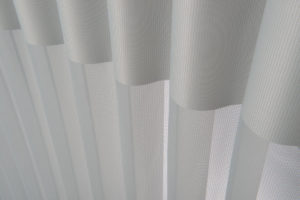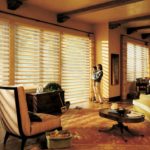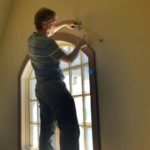No Peeping Toms: Privacy for Your Biggest Windows

Nothing adds drama to a room like a wide view of Pikes Peak or the sunlight streaming across the high plains near Colorado Springs. Since the mountains are visible from nearly anywhere, a sliding glass door or a window that stretches from wall to wall adds value to the home.
As beautiful as the view is, privacy can be a concern. You don’t want strangers looking into your windows whether by accident or intentionally. Even during the day, you may want to control the amount of light that is streaming into your living space.
Here are a few options for window coverings that allow you to control the amount of privacy and sunlight coming through your biggest windows.
Custom Drapes
We can design custom drapes with two layers; a sheer layer that lets the sun and view in while diffusing the light and an opaque layer that screens outside eyes at night. Even your sheer drapes will be full, with many folds that obscure the view from outside if you forget to pull the opaque drapes closed.
Vertical Blinds
Vertical blinds are a popular option for sliding glass doors. Hunter Douglas makes custom vertical blinds in fabric, metal and vinyl with many finishes and patterns, so that you can choose exactly what you need for your home. Vertical blinds can also be an economical option.
Shutters
Shutters also come in many materials and in a variety of finishes. You probably knew that, but did you know you can get them with different operating styles? Hunter Douglas offers shutters that open like a bifold door or you can get shutters that open outward, like a casement window. Another style works on a track that allows the panels to slide past each other, like a sliding closet door.
Privacy Sheers
The ultimate technology in privacy window coverings is Hunter Douglas Luminette privacy sheers. These are made with vertical slats that are attached to the fabric of your choice. The slats spin 180º in either direction, allowing you to open or close them. The fabric hangs between them, screening and diffusing the sunlight when the sheers are open.
Do you need a beautiful way to make the most of your biggest windows while preserving your privacy? Call us today!
Would you like to know more about window treatments? Sign Up for our mailing list and receive our report, Window Covering Basics – All About Drapes, Blinds, Shades and Shutters!
;






 We know it’s hard to believe, but not everybody wants custom draperies. Sometimes a room needs the clean look you get from blinds.
We know it’s hard to believe, but not everybody wants custom draperies. Sometimes a room needs the clean look you get from blinds.

 Picture this: You decide not to hire a designer with the idea of saving some money. “It’s just drapes,” you think. How hard could it be?
Picture this: You decide not to hire a designer with the idea of saving some money. “It’s just drapes,” you think. How hard could it be?
